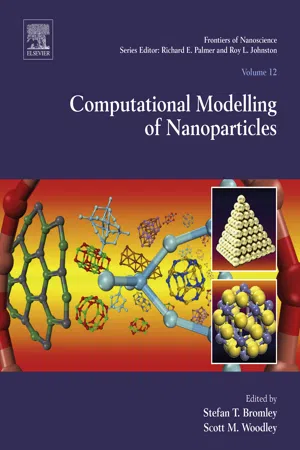
- 351 pages
- English
- ePUB (mobile friendly)
- Available on iOS & Android
Computational Modelling of Nanoparticles
About This Book
Computational Modelling of Nanoparticles highlights recent advances in the power and versatility of computational modelling, experimental techniques, and how new progress has opened the door to a more detailed and comprehensive understanding of the world of nanomaterials. Nanoparticles, having dimensions of 100 nanometers or less, are increasingly being used in applications in medicine, materials and manufacturing, and energy. Spanning the smallest sub-nanometer nanoclusters to nanocrystals with diameters of 10s of nanometers, this book provides a state-of-the-art overview on how computational modelling can provide, often otherwise unobtainable, insights into nanoparticulate structure and properties.
This comprehensive, single resource is ideal for researchers who want to start/improve their nanoparticle modelling efforts, learn what can be (and what cannot) achieved with computational modelling, and understand more clearly the value and details of computational modelling efforts in their area of research.
- Explores how computational modelling can be successfully applied at the nanoscale level
- Includes techniques for the computation modelling of different types of nanoclusters, including nanoalloy clusters, fullerines and Ligated and/or solvated nanoclusters
- Offers complete coverage of the use of computational modelling at the nanoscale, from characterization and processing, to applications
Frequently asked questions
Information
How to design models for ceria nanoparticles: Challenges and strategies for describing nanostructured reducible oxides
† Departament de Ciència de Materials i Química Física & Institut de Química Teòrica i Computacional, Universitat de Barcelona, Barcelona, Spain
‡ Institució Catalana de Recerca i Estudis Avançats (ICREA), Barcelona, Spain
1 Corresponding authors: email address: [email protected], [email protected]
Abstract
Keywords
1.1 Introduction
1.1.1 Cerium dioxide: Properties and applications
1.1.2 Nanostructured ceria and its role in catalysis
1.1.3 Outline of the chapter
Table of contents
- Cover image
- Title page
- Table of Contents
- Copyright
- Contributors
- Introduction to modeling nanoclusters and nanoparticles
- Chapter 1: How to design models for ceria nanoparticles: Challenges and strategies for describing nanostructured reducible oxides
- Chapter 2: Simulating heterogeneous catalysis on metallic nanoparticles: From under-coordinated sites to extended facets
- Chapter 3: From nanoparticles to mesoporous materials
- Chapter 4: The DFT-genetic algorithm approach for global optimization of subnanometer bimetallic clusters
- Chapter 5: Clusters and nanoparticles: The experimental–computational connection to understanding
- Chapter 6: Stress-driven structural transitions in bimetallic nanoparticles
- Chapter 7: Modeling realistic titania nanoparticles
- Chapter 8: DFT modeling of metallic nanoparticles
- Chapter 9: Melting and structural transitions
- Index